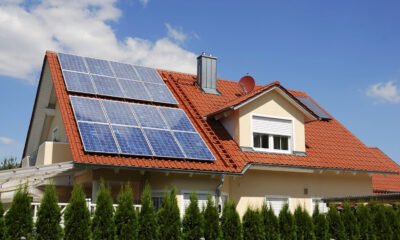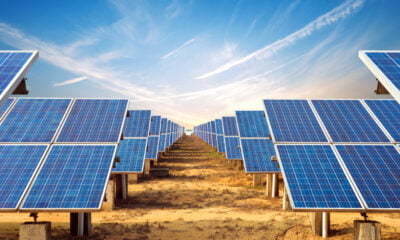

Energy
Considering the Differences of Active and Passive Solar Energy
Solar energy has become tremendously popular in the United States in recent years. In 2018, we had enough solar energy installations to power 12.3 million homes.
If you are considering installing solar energy to heat your home, it is vital that you understand that there are different types of energy that can be used. The majority of energy can go into two separate categories, which is active and passive solar energy.
Although both active and passive energy come from the sun, there are a few big differences between them. If you are new to solar, there is a good chance this might sound a little confusing, so here is a short article on the differences between both.
What is Solar Energy and Why are so many People going Solar?
Solar energy is energy that can help power people’s houses, businesses, schools and etc. This energy is harvested from the sun which then creates electricity. The sun is like an enormous generator. The sun sends its energy in the form of photons and once the solar panels receive these photons, it will then be able to change it into usable power.
Solar power has been growing in popularity in recent history because it is sustainable, reusable and it doesn’t harm the environment like other energy sources do. The more people that use solar energy means less pollution on our planet. If everybody on Earth was to harvest this energy, fossil fuels or other unclean energy would not be required.
In recent years, there have been some major breakthroughs in solar power technology, which have made it easier for us to have solar installations made in our homes and businesses. Unfortunately, even with all these new technology inventions, experts still believe not enough of us are utilizing solar energy. In the United States, less than 2% of the total electricity generation uses solar energy. You may find this figure surprising, however the number is set to grow significantly over the next few years. Because of the increasing popularity, it is becoming easier to install and maintain, plus it will be a lot cheaper to buy solar products in comparison to what it was before. Throughout the world, governments are offering tax breaks and other types of incentives to promote the idea of people investing in solar panels.
What Exactly is Active Solar Energy?
When people discuss solar power, they are normally talking about active solar energy. To use active solar energy, an external energy source is needed. For example, a backup system that is used in radiators.
Normally people use solar panels, which are normally mounted onto the roof of a house. These panels are often installed vertically or horizontally, but some also have them stationary. Whichever way you’d prefer, it doesn’t really matter as long as the panel has access to plenty of sunlight.
Active energy uses air or liquid to take the heat from the sun’s rays. It then moves into the storage container, which later converts into power. You will find that liquid is used in most systems. Most solar power manufacturers feel that liquid is better at conducting both energy and heat. However, others prefer to use air because it doesn’t freeze during the colder times of the year. In countries that experience very cold winters, you will find most active solar panels using liquid.
Whether it uses air or liquid, they both can provide energy to heat or cool your home.
What is Passive Solar Energy?
Some houses are specifically designed so that passive solar energy can provide energy to heat or cool down your home through exposure. Once sunlight hits your home, the design of your house will be able to reflect, transfer, and absorb the sun’s energy. These can be done by the building materials used to build your home.
Architects design your home around where they predict air movements that are caused by the heat from the sun. The goal of experienced architects in this field is the following:
- Choose the right material
- Put these materials in the right places
- Make sure these materials are installed in the right direction
- To make the set up effective
- To make it efficient
- To help create natural heating
- To help cool the building
The main difference between passive and active energy is that passive is more about the design of the building. To create passive energy, you don’t need any mechanical or electrical devices such as fans or pumps to help move the energy.
How does Heating & Cooling work with Solar Passive Energy?
The main aim for a home designed to be powered by passive energy is to capture and absorb heat from inside the house. When there is no sun outside, it is then released to keep the temperature inside the home stable.
Most homes or buildings that use passive energy use a thermal mass for heating and glass that is south-facing.
Passive energy works by cooling a house by lowering the amount of unwanted heat gained throughout a day. It transfers warm air inside for colder air outside. Because it will store cool air from each night, it will help moderate the temperature in the building throughout the day. The easiest way to improve your home’s temperature is by using large trees as shade, cross-ventilation and other forms of shade, especially on the south facing glass.
Pros & Cons of using Passive Solar Energy
There are advantages and disadvantages of using passive energy such as:
Pros:
- Environmentally friendly: Most homeowners who choose to use passive solar energy, tend to use much less fossil fuels which is great for the environment.
- Cut the cost of your household bills: Energy from the sun is free! You don’t have to worry about financially getting hit hard with your next utility bill.
- The equipment used is not that expensive: Although the price of equipment used for active solar energy has recently dropped in price, it can still prove quite expensive for many of us, the materials needed for passive solar energy won’t break the bank. This allows homeowners with a small budget to have an eco-friendly home.
Cons:
- The entire cost can be expensive: Although most of the equipment needed is cheaper than active solar energy material, changing your home or designing your house to fit a passive solar energy system can prove expensive. If your house wasn’t initially designed for a passive solar energy system, you might knock down and replace walls and windows, both inside and outside your building.
- Location, Location, Location! Unfortunately, you can’t have a passive solar power system in every home due to the house’s location. Just because a system works perfectly in Florida, doesn’t necessarily mean it will work well in Texas. It takes a lot of research and most people will be forced to seek advice from a professional passive energy expert.
- Might not provide enough energy needed for your home: For those who live in extremely cold areas, passive solar energy might not be able to provide you with enough heat through the winter period. You may have to use natural gas, coal or petrol to help give your home that extra bit of heat. The opposite happens in warmer areas, when passive energy causes too much heat, the system struggles to keep the building cool.
With more and more people installing solar panels and introducing new eco-friendly systems into their homes, expect to see a lot more people using solar energy to keep their home.


 Environment10 months ago
Environment10 months agoAre Polymer Banknotes: an Eco-Friendly Trend or a Groundswell?

 Environment12 months ago
Environment12 months agoEco-Friendly Home Improvements: Top 7 Upgrades for 2025

 Features9 months ago
Features9 months agoEco-Friendly Cryptocurrencies: Sustainable Investment Choices

 Features10 months ago
Features10 months agoEco-Friendly Crypto Traders Must Find the Right Exchange





























